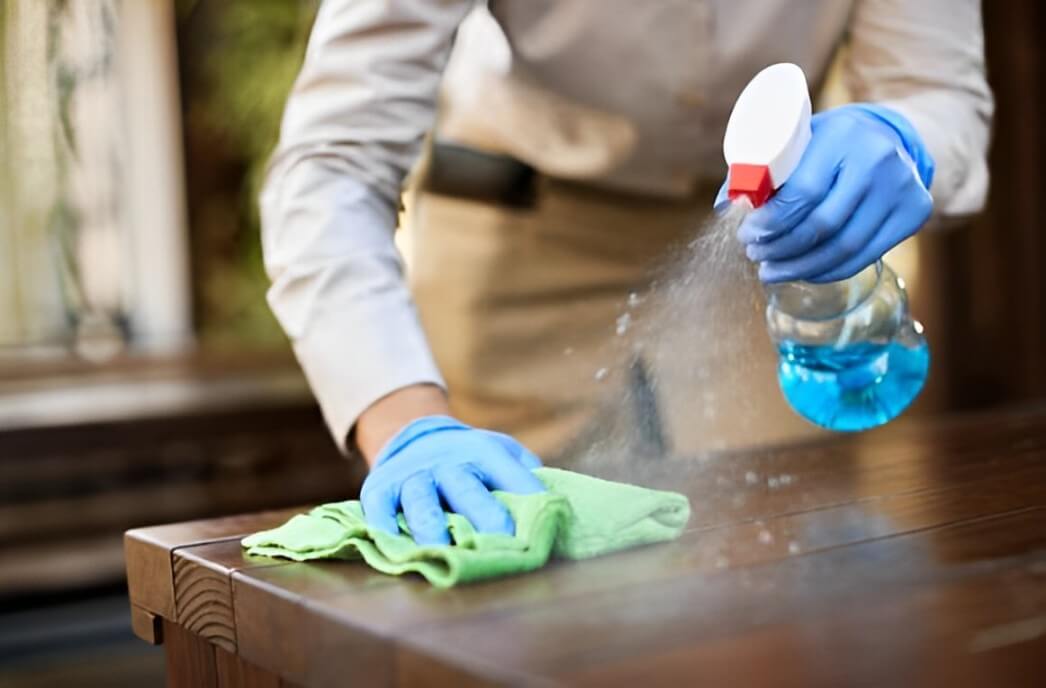How to Dust Properly
Spills and stains are generally much easier to clean up when you attack them right away. When you treat that tomato sauce splatter on your dress shirt without delay, for instance, it offers little resistance.
If you wait until the next day, you’ll be sporting a permanent-looking red polka dot that you’ll expend a lot more cleaning solution and time getting out. Similarly, clothing or carpet stains are easiest to remove when they’re fresh. The longer you wait, the more chance the stain has to set. That’s why Maidsway gives you the Essential Guidelines for Dusting.
The rare exception to this rule: Mud tracked onto your carpet is easiest to clean when you’ve let it dry first. Wait until it’s bone dry and crumbly; then just vacuum it up.
- Always work from the top down, and then vacuum the dust that settles to the floor. Don’t just dust the places you can see but the places you can’t. When doing a thorough cleaning, include the tops of doors, walls, molding, ceiling fans, window treatments, and even lightbulbs (when lights are off and bulbs are cool).
- Instead of dusting around items such as collectibles, books, and telephones, move them aside and get underneath. When dusting a flat surface, move the cloth smoothly from one end to the other, stopping at the end. Don’t flick the cloth, or dust will merely be released back into the air before settling on the floor, instead of getting trapped by your cloth.
- Avoid dusting sprays, or use them sparingly. They contain oily substances that attract more dust. They also build up over time and can damage a finish. On wood, dust in the direction of the grain.

Choosing the Best Dusting Tools
1. Microfiber Cloths
Microfiber cloths are among the best tools for dusting due to their superior ability to trap and hold dust particles. The fine fibers create a larger surface area for picking up dust without simply spreading it around. They’re also washable and reusable, making them a cost-effective and environmentally friendly choice.
2. Dusting Brushes
Dusting brushes, including those with extendable handles, are great for reaching high or delicate surfaces. Brushes with soft, flexible bristles can gently remove dust from intricate items like chandeliers, figurines, and vents without damaging them.
3. Vacuum Attachments
Many vacuum cleaners come with specialized dusting attachments. The upholstery or dusting brush attachment can effectively remove dust from furniture, curtains, and other fabric surfaces. A vacuum with a HEPA filter is ideal for trapping fine dust particles and reducing airborne allergens.
4. Dusters
Extendable dusters, including those with fluffy or feathered heads, are excellent for reaching ceiling fans, high shelves, and other elevated areas. Fluffy dusters can pick up larger dust particles, while electrostatic dusters can attract and hold dust more efficiently.

Effective Dusting Tips
1. Dust from Top to Bottom
Start dusting at the highest points in a room, such as ceiling fans and high shelves, and work your way down to lower surfaces. This approach ensures that dust falls onto surfaces you haven’t yet cleaned, preventing you from having to redo areas.
2. Use a Dusting Spray
While some prefer dry dusting methods, using a dusting spray can enhance the effectiveness of your dusting routine. A light spray on your dusting cloth or directly on surfaces helps to trap dust particles and reduce static cling. However, be cautious with spray products on electronics and other sensitive items.
3. Don’t Forget the Air Vents
Air vents can be significant dust collectors. Use a vacuum attachment or a duster to clean the grilles and remove dust from the vents. This helps prevent dust from circulating throughout your home when the HVAC system is running.
4. Regular Maintenance
Dusting should be a regular part of your cleaning routine. Depending on your home environment and lifestyle, dusting once a week is typically sufficient. High-traffic areas or homes with pets may require more frequent dusting.
5. Minimize Clutter
Reducing clutter not only makes dusting easier but also helps in reducing the amount of dust that accumulates. Less clutter means fewer surfaces for dust to settle on, making your dusting efforts more efficient.

Conclusion
Dusting is a key aspect of maintaining a clean and healthy home environment. After reading this article, I assure you that now you know how to dust properly. By following the golden rules of dusting, you ensure that your living space remains not only visually appealing but also free from allergens and dust that can impact your well-being. Adopting the best dusting methods, using the best dusting tools, and integrating effective dusting tips into your regular cleaning routine are essential steps for achieving a dust-free home.
FAQs
What is the best tool for dusting furniture?
Microfiber cloths are excellent for dusting furniture as they trap dust particles effectively without spreading them around. For intricate items or delicate surfaces, a soft dusting brush is also useful.
Can I use a regular cloth for dusting?
While a regular cloth can be used for dusting, microfiber cloths are preferred because they are designed to attract and hold dust more effectively. Regular clothes may simply move dust around rather than capture it.
How do I clean dusting tools?
Microfiber cloths and dusters should be washed regularly according to the manufacturer's instructions. Typically, you can machine wash microfiber cloths in warm water without fabric softener.
How can I dust hard-to-reach areas effectively?
For hard-to-reach areas like ceiling fans and high shelves, use extendable dusters with flexible heads. Vacuum attachments can also help reach narrow spaces. Regularly dust these areas to prevent excessive build-up.
How can I manage dust in homes with pets?
Homes with pets often require more frequent dusting due to pet hair and dander. Use a vacuum with a pet-specific attachment, wash pet bedding regularly, and consider using air purifiers to help manage dust and allergens.

